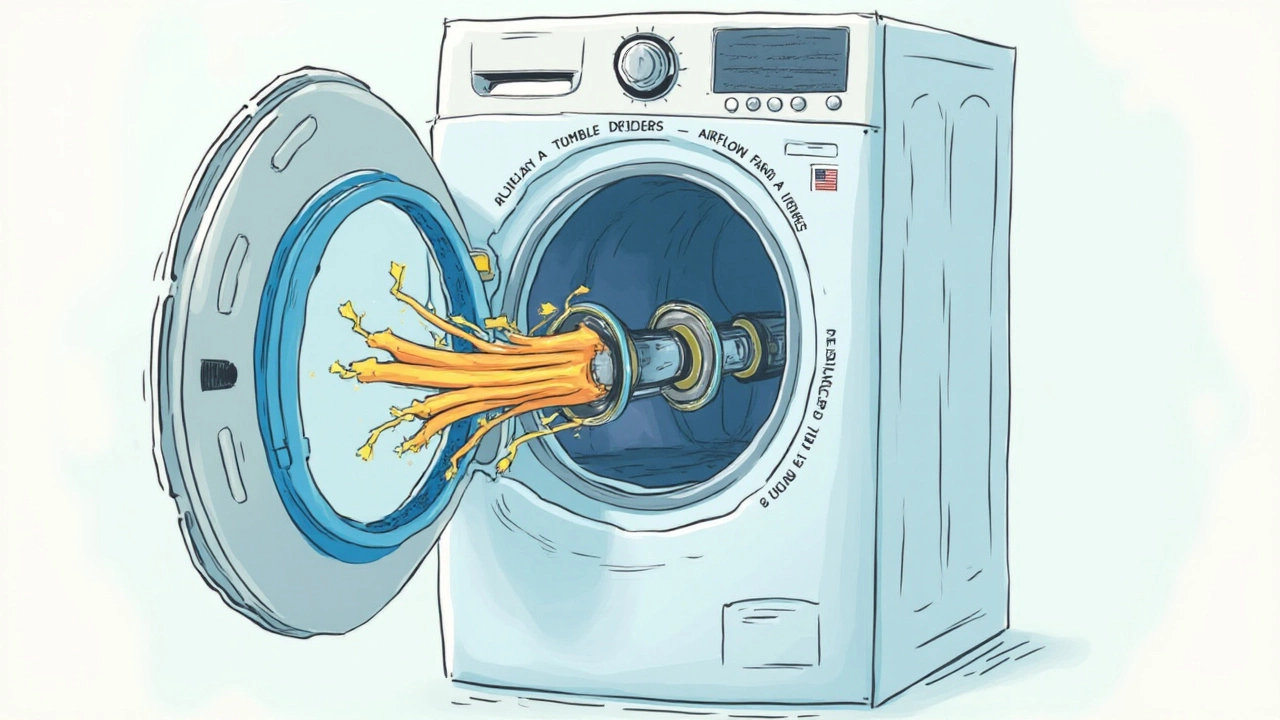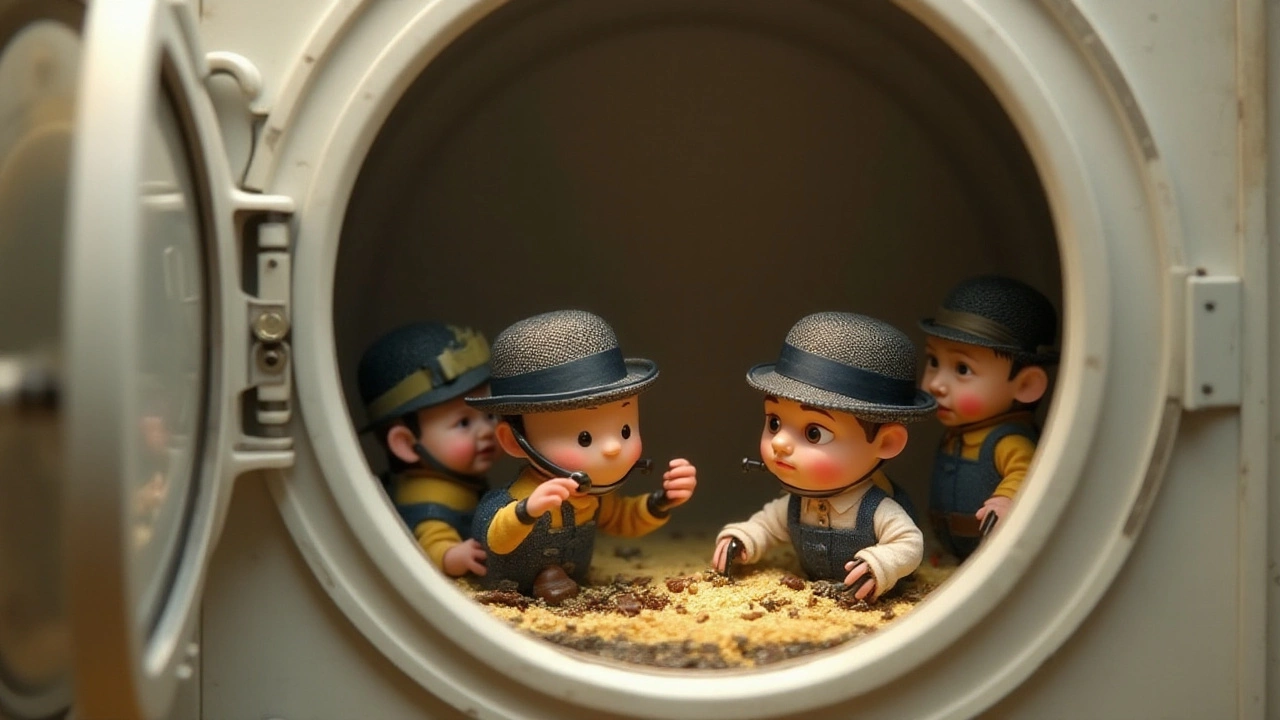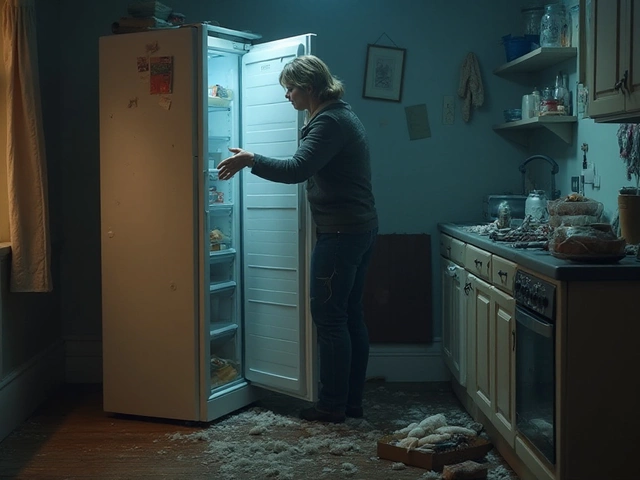Everybody loves the convenience a tumble dryer brings, turning laundry from a time-consuming chore into a smooth operation. Yet, every now and then, these trusty machines seem to have a mind of their own, throwing a wrench into our well-planned routines. Whether it's the dreaded 'clothes still damp' issue or the sudden appearance of an unwelcome whir or clang, these problems are not just inconvenient—they're downright exasperating.
Before you punch in the number for a repair service, let's consider the quirks of your dryer. Understanding these hiccups can not only save you some dollars but also offer a sense of accomplishment. In the following sections, we’ll explore the roots of common dryer troubles, easy fixes you can manage on your own, signs that it's time to bring in the experts, and tips on keeping your dryer running smoothly. Consider this your go-to guide on taming the tumble dryer beast!
- Identifying Dryer Problems
- DIY Solutions and Quick Fixes
- When to Call a Professional
- Preventive Maintenance Tips
Identifying Dryer Problems
When your trusty dryer starts acting up, the first step to restoring its function is successfully pinpointing the problem. Finding the root of the issue can sometimes be perplexing but breaking it down into smaller, recognizable symptoms can make the task easier. For instance, if you find your clothes remaining damp, consider checking if the settings are too low for the load or if the lint filter might be packed with fluff. A clogged filter not only decreases efficiency but can also be a fire hazard. It's essential always to clear it after each cycle to maintain dryer performance.
Unusual noises are another common sign that something might be afoot. A screech sometimes indicates a worn-out belt that's slipping as it turns the drum, while a continuous thumping could mean that the rollers are due for a replacement. Dirt and residual fabric soften wear over time, making routine inspection a good preventative measure. In some instances, the drum might be misaligned, which requires professional attention, particularly if you also notice wobbling. Regular check-ups may prevent such serious wear and tear, ensuring your tumble dryer keeps running smoothly.
Signs of Electrical Issues
Electrical issues, though less frequent, are significant causes of concern. If your dryer fails to start altogether, the circuit breaker might have tripped, or the power cord could be chewed up or damaged. Sometimes, resetting the dryer by unplugging it for a few minutes fixes minor glitches. But if there’s a persistent electrical issue, it's prudent to consult an expert, keeping safety in mind. Thoroughly examining cords and electronic panels is vital, but they should only be inspected by those with electrical troubleshooting skills to avoid accidents.
"Preventing problems is the key to extending your dryer’s lifespan," advises appliance expert John Antonelli, adding that attention to regular maintenance can stave off many common issues.
For those interested in numbers, let’s illustrate with this useful chart highlighting potential DIY solutions to common problems. Understanding these metrics can save a lot of time and frustration:
| Issue | Possible Cause | DIY Solution |
|---|---|---|
| Clothes not drying | Clogged Lint Filter | Clean the filter |
| Noisy Operation | Worn-out Belt | Replace belt |
| Won’t Start | Tripped Circuit | Check breaker |
By keeping these guidelines in mind and listening to your dryer when it speaks through squeaks, rumbles, or stubborn stops, you can often quickly identify what needs fixing. Remember, handling the simpler problems yourself not only provides a sense of accomplishment but also ensures the longevity of your appliance. Whether it's through understanding the rhythm and sounds of your dryer or recognizing when the issue is beyond your expertise, identifying problems is the first step to dryer repair success.

DIY Solutions and Quick Fixes
It's time to get your hands dirty and unravel the mystery behind some of those common dryer repair problems without diving deep into your pockets. No one likes the idea of waiting for a technician or paying a hefty sum for something you could handle yourself. First off, let us tackle the situation where clothes come out damp. Often, the culprit here is a blocked lint trap or a vent that's seen better days. Grab a screwdriver, remove the lint trap housing, and give it a good clean. Don't forget to check the duct connected at the back for any blockages. Sometimes, a good vacuuming session is enough to restore your dryer's functionality.
But what if your tumble dryer is making those strange noises? Those unsettling sounds can often be traced back to the drum rollers. Worn-out rollers are easy to identify and change. Remove the front panel, take a peek, and if they look worse for wear, swap them out. A little patience and a basic toolkit are sufficient here. And since a stitch in time saves nine, remember the golden rule—fixing these minor issues promptly averts more serious damage later. You may not know this, but aligning dryer feet could also end your noise troubles. Uneven positioning often causes vibrations that mimic recurring thunder.
Let’s shift gears to when the dryer refuses to heat. This is one of the scariest prospects, but calm your nerves because quite often, it’s just a tripped circuit breaker. Head over to your electrical panel, flip that switch, and power up the machine. If the heat's still MIA, the thermal fuse could be a goner. Replace it yourself and you'll feel like magician conjuring warmth. For this, dismount the back panel, locate the fuse, chuck it, and put in a new, shiny one.
Another frequent gripe is when a dryer doesn't start at all. If your machine is dead-on-arrival, take a breath. The issue could be something as simple as a faulty door switch. Unscrew the hinge, extract the switch, and swap it. Got an older model? The belt might be snapped—leaving your poor drum immobile. An easy fix, really. Purchase a new belt, loop it around the drum, and thread it through the idler pulley. It feels like you're walking a tightrope, but hang tight, you've got this.
Did you know that according to a US Fire Administration report, dryers are responsible for an average of 2,900 fires, causing 5 deaths, 100 injuries, and $35 million in property loss each year? Cleaning isn’t just about efficiency, it’s a safety measure too. Stay vigilant, inspect for signs of wear and tear regularly, and never shy away from DIY. As inventor Thomas Edison once said:
“Opportunity is missed by most people because it is dressed in overalls and looks like work.”
Armed with these quick fixes, you'll stride confidently into your laundry room, ready to take charge of your appliance with newfound knowledge and a toolkit at the ready. Next time your dryer starts acting up, you'll face it head-on, ready to diagnose and fix before picking up the phone for help.

When to Call a Professional
There comes a point when your trusty tumble dryer might present challenges that extend beyond your DIY capabilities. While basic maintenance like clearing lint filters or checking airflow is well within reach, some issues require the experienced hand of a professional. Take, for instance, the intricate wiring and sensitive electronics in modern dryers that could scare anyone away from tinkering. If your dryer shows signs of faulty wiring, like flickering displays or erratic behavior, it would be wise to let a skilled technician handle the labyrinthine circuits.
An unsettling, persistent noise, despite having checked for foreign objects within the drum or ensuring all parts are tightened correctly, is another red flag. Such noises can point to internal mechanical issues, such as worn bearings or a malfunctioning motor. These complex components demand specialized tools and expertise to prevent further damage or even safety hazards. While DIY resources can inspire confidence, they can't replace expert knowledge when the cause of a problem remains elusive.
Unpredictable performance, such as occasional failure to start or spontaneously shutting off, raises concerns over the health of the dryer’s core components. In particular, the thermal fuse and thermostat are parts where malfunctions often hide, impacting the dryer's operation. A qualified technician can assess, diagnose, and repair these parts effectively, ensuring your appliance runs smoothly without risk. Given the hazards associated with incorrect repairs, such as potential fires, it's clear why such tasks are best left to someone with relevant credentials.
According to the Home Appliance Standards Program, dryers account for 92% of the energy consumed by clothes washers and dryers combined, highlighting the importance of maintaining their efficiency.
One should also consider reaching out to repair services when electrical issues manifest, such as frequent circuit breaker trips during dryer use. This could signal an underlying problem within the dryer's power system, and meddling without a full understanding could have dire consequences. Troubleshooting complex electronics without adequate training might, at best, void any existing warranty, and at worst, lead to costly or dangerous mistakes. Enlisting professional support ensures that all safety standards are adhered to, prolongs the appliance's life, and maintains its warranty.
Lastly, for seemingly small problems that recur no matter how thoroughly you investigate, consulting a professional could save time and sanity. By performing diagnostics, professionals can identify obscure issues and prevent them from escalating, which could save money in the long run. The peace of mind that comes from a certified technician's touch is invaluable, especially given how integral your dryer is to everyday life. Don't hesitate to make the call when faced with concerns that your skills or comfort level can't extend to, ensuring not only a working dryer but a safer home environment.







